Baba ghanoush, lamb kebabs, baklava, braziers and spices… a mysterious and romantic image of Morocco comes to mind, when thinking of making some of their delectable and well known dishes.
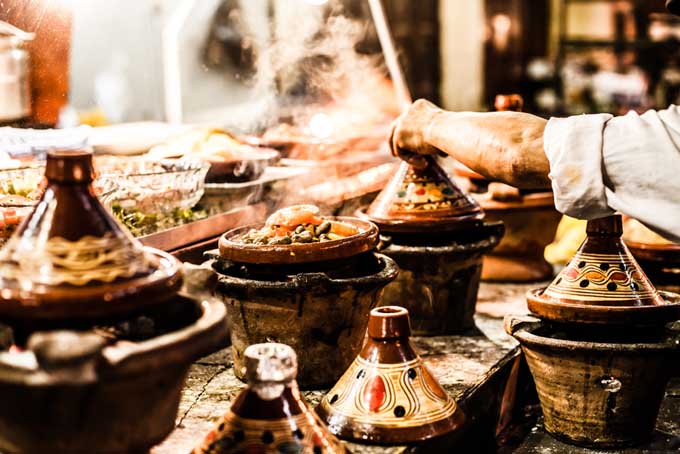
Given its location on the northwestern edge of Africa, Morocco’s cuisine today is a distinctive amalgamation of the many people who have called it home.
The food prepared in this region reflects the influence of centuries of unique cultures who have called it home, and who brought commerce and trade to this region’s shores.
Let’s delve into how this unique blend of flavors came about, explore some of the staples of the diet there, and then jump in to sample some the local gastronomy with a couple of recipes representative of a typical menu.
A Myriad of Influences
Moroccan cuisine comes to us today from a variety of influences – indigenous peoples, traders, invaders, immigrants and colonizers have all played a role in the development of the local culture and dietary habits, as each brought new ingredients, cooking techniques and cultures that remain influential today.

Over 2,000 years ago, the first known inhabitants were nomadic Berbers who first gave us the combination of ingredients still found in soups and stews today.
They took advantage of locally growing produce and combined olives, figs and dates when preparing lamb and poultry, mixing everything in one pot for wonderful stews. For Foodal’s own delicious homage to this wonderful tradition, check out our Moroccan lamb, veggie, and lentil stew.
This heritage is found in Morocco’s favorite dish, tagine. It actually gets its name from the cooking vessel the stews are made in, a glazed earthenware pot with a conical lid that seals in flavors.
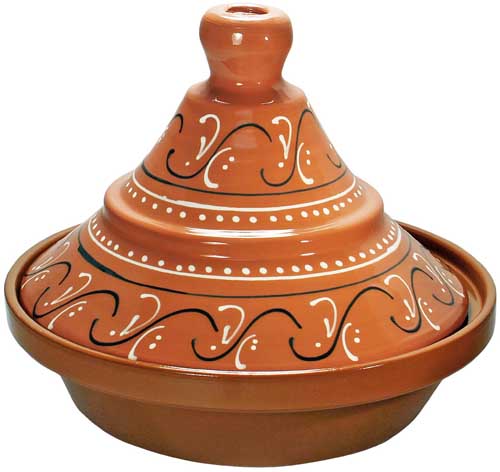
Foodal recommends this 2-Quart Terra Cotta Tagine available on Amazon
When the Arabs invaded this land in the 7th century, they introduced new breads, cereals, grains and spices, as well as the sweet and sour flavor pairings favored by the Persians like raisins with lentils or apricots in couscous dishes.
Cinnamon, dried ginger, saffron, cumin, and caraway as well as nuts like almonds and walnuts found their way into the souk, or marketplace, and into the pots atop their portable clay cooking braziers.
When the Moors arrived at Gibraltar from Andalusia in the 15th century, they introduced new varieties of olives, and oranges and lemons – all of which are still very popular in Moroccan cooking.
And later, the Jewish Moors left their stamp on the region with their practical preserving techniques, which are evident in pickled lemons and vegetables that maintain popularity today.
Of particular importance to Moroccan culinary habits was the technique of barbecuing and grilling meat on skewers, known as kebabs, which the invading Ottomans brought with them during the 16th century conquest.
They were also responsible for pioneering local tastes for baklava and yogurt, and increasing the popularity of lamb.
France has also played a significant role. Although their colonization of the area in the 20th century was brief compared to that of other empires, French flavor and influence can still be found in the Moroccan fondness for café culture, pastries, and even wine.
Today’s Culinary Practices
As a country that observes the Islamic faith, the Muslim diet restricts the consumption of pork and alcohol, although some individuals will be seen enjoying wine and buying alcohol in the larger cities.
During Ramadan, Moroccans consume a thick soup called harira, which is served at night after a day of fasting, and is made of lamb, beans and fresh dates.
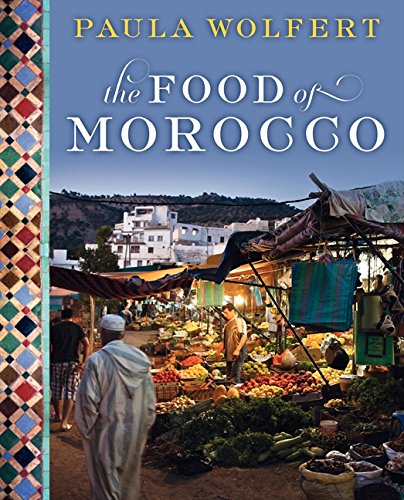
Foodal recommends The Food of Morocco by Paula Wolfert for a definitive recipe and how-to book for cooking Moroccan.
At the end of Ramadan, a family will dine on a typical feast of roast lamb dipped in cumin; cashew bisteeya, a pie made with phyllo pastry; couscous and custard.
All of this is followed by mescouta, a date bar enjoyed for dessert on special occasions, and served with the ever-present mint tea.
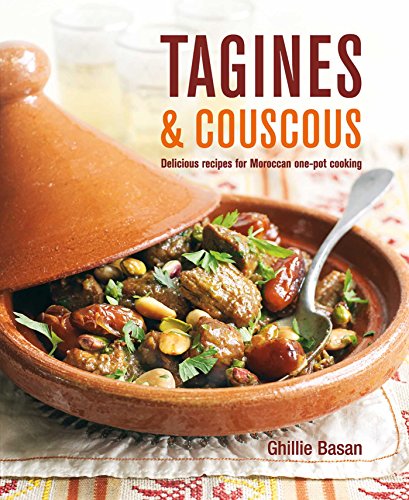
Tagines & Couscous: Delicious Recipes for Moroccan One-pot Cooking is another great introduction.
Flatbread (like pita, and other varieties) is a staple of every meal and is considered sacred – according to tradition, it will never be thrown away, and any pieces that are old or that have fallen on the floor will be served to the animals.
This bread is often baked in communal ovens, and it replaces cutlery as Moroccans will scoop up food with a bit of bread held between the thumb and first two fingers.
Couscous, made from semolina (like this basic homemade pasta dough) is served in a wide variety of styles and is another dietary staple. The national dish is tagine, a rich and flavorful stew made of lamb or poultry, chickpeas, vegetables and spices.
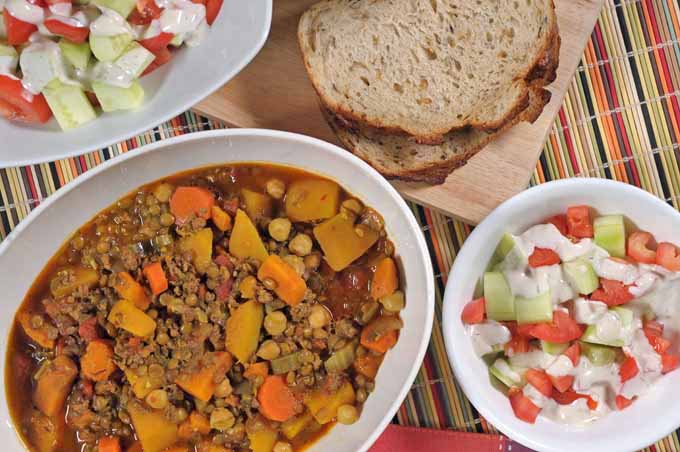
And of course mint tea is a must with every meal, with the presentation and pouring being nearly as important as the actual drinking of it.
Except in years of severe drought, Moroccan farmers produce all of the country’s food. Local fruits and vegetables include: oranges, lemons, dates, figs, melons, olives, apricots, tomatoes, potatoes, peppers, almonds, cashews and walnuts, and various cereals and grains.

With a large coastline that runs along the Mediterranean and North Atlantic, fish and seafood is abundant. Beef is rarely grown or consumed, with lamb and poultry being the most often consumed sources of meat.
The Spice Bazaar
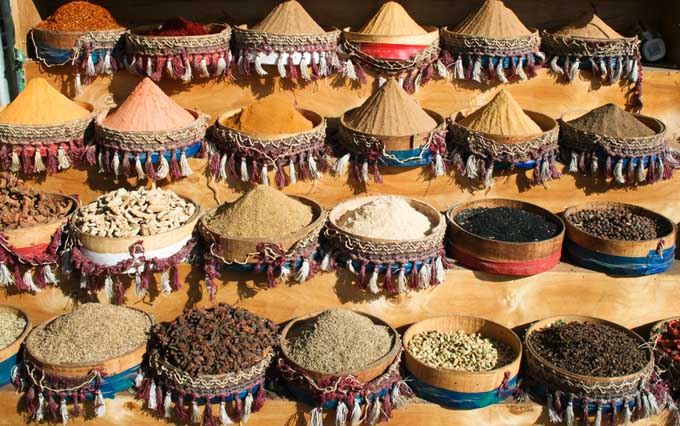
Central to the flavor palette in this region, spices are used in almost every dish.
- A common spice blend is ras el hanout, with varying quantities of ground cinnamon, cumin, cloves, ginger, and coriander.
- Cumin is served alongside salt and pepper, it’s so fundamental to the local diet.
- Cinnamon goes into cashew pies, pastries, and baklava as well as tagines and fruit dishes.
- Paprika and chilies from the Sahara find their way into veggie tagines and tomato-based recipes.
- Cloves are found in soups and broths.
- Saffron is grown in the south, and is used in pastries, entrees and soups.
- Cardamom is also a staple spice in custards, sweets and cream desserts.
- Sesame seeds go on pastries and are ground into a sweet paste, mixed with honey.
Herbs and Oils
- Cilantro and parsley are used to flavor savory dishes.
- Mint is revered for tea making, and in the winter when it’s out of season, absinthe sometimes replaces it.
- Verbena and marjoram are also used in teas.
- Anise goes on pastries and breads.
- Thyme is used in desserts, combined with roasted figs and apricots.
- Olive oil is widely used as the cooking oil of choice.
- Argan oil (from the fruit of the Argan tree, which is indigenous to Morocco) is used for salad dressings, drizzled over couscous, and for dunking the breakfast bread in.
As you can see, the culinary flavors of Morocco are broad and varied – rich and spicy, with fresh fruits and vegetables and delectable sweets for contrast. Once you’ve sampled food from the region, these remarkable blends will have you coming back for more.
So, here are a couple of recipes to start you out on the road to Morocco.
Moroccan Chicken Tagine
This rich stew with its unexpected flavor combinations is rich and tasty, and will have everyone coming back for seconds. It goes well with a cool tabbouleh salad and flatbread, and the meal can be finished off with mint tea and date bars for dessert.
- 1 tablespoon olive oil
- 2 boneless skinless chicken breasts cubed
- 1/2 sweet onion chopped
- 3 cloves garlic minced
- 1 smallish butternut squash peeled and cubed
- 1 can garbanzo beans rinsed and drained
- 1/2 cup sultana raisins
- 1 carrot peeled and chopped
- 1 can diced tomatoes with juice
- 1/4 cup blanched almonds slivered
- 1 1/2 cups vegetable broth
- 1 tablespoon brown sugar
- 1 tablespoon Lemon juice
- 1 teaspoon sea salt
- 1/2 teaspoon fresh ground black pepper
- 1 teaspoon ground coriander
- 1 teaspoon cinnamon
- 1 teaspoon cumin
- Dash of cayenne pepper
- Heat a large Dutch oven to medium high heat and add the oil. Add the chicken, onion and garlic and cook until browned, about 15 minutes.
- Add the squash, garbanzos, raisins, carrot, tomatoes, almonds, broth, sugar and lemon juice and stir well.
- Season with the salt, pepper, coriander, cinnamon, cumin and cayenne.
- Bring all ingredients to a boil then reduce heat to a medium-low simmer and continue cooking for 40 – 45 minutes or until the vegetables are tender.
*This dish does equally well with lamb or beef, but the meat should be marinated for at least an hour to tenderize before cooking.
For a vegetarian version, omit the chicken and add: 1 medium zucchini, cubed, 1 large potato, peeled and cubed, and ½ cup fresh green beans, cut into 1/2” pieces.
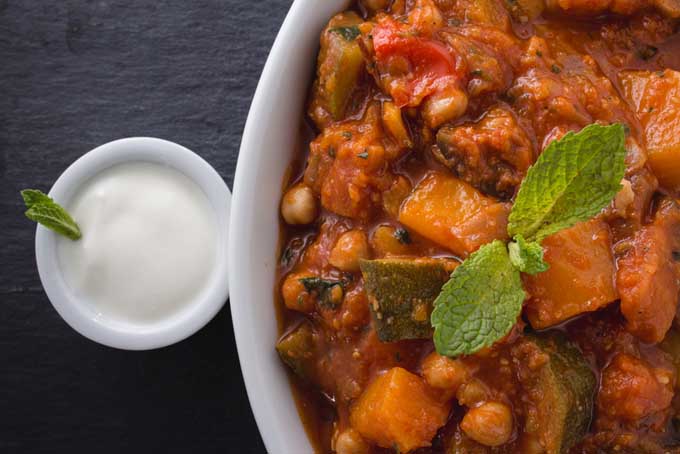
Tabbouleh Salad
This tangy salad is cool and refreshing, the perfect complement to shish kabobs, meat grilled on the BBQ, or tagine.
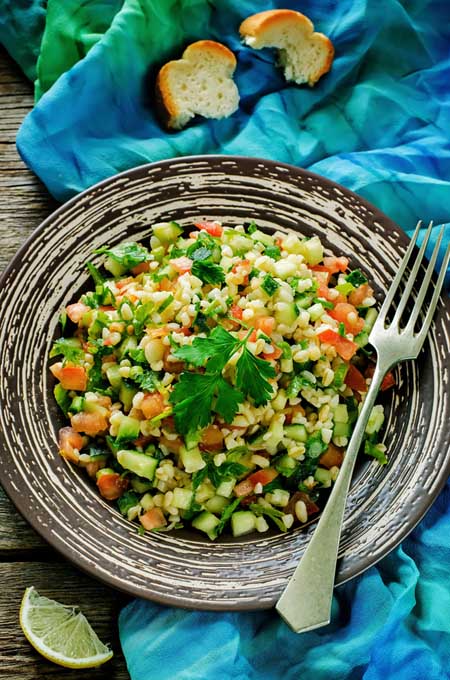
For best results, ensure that the mint and parsley are chopped well and the cucumbers, tomatoes and onions are cut into small bite-sized bits.
- 1 cup bulgur *
- 1 cup boiling water
- 2 bunches parsley flat or curly leaf
- 1/2 cup fresh mint chopped
- 4 large tomatoes chopped
- 1 English cucumber chopped
- 4 green onions whites and 1/3 greens, chopped
- 1 clove garlic minced
- 1/4 teaspoon fresh ground pepper
- 1/8 teaspoon sea salt
- 1 lemon juice only
- 1/2 cup olive oil
- 1/3 cup sheep feta crumbled optional
- In a small bowl, add the bulgur and boiling water and mix well. Cover with a tea towel and set aside to cool while preparing the rest of the ingredients.
- Chop the parsley, mint, tomatoes, cucumber, and green onions and set aside.
- In a small bowl, whisk together the lemon juice and garlic. Add the olive oil gradually and whisk well. Season with salt and pepper, giving a final whisk.
- In a large glass bowl, place the bulgur and add ¾ of the salad dressing to the cool bulgur, mixing in well.
- Add the salad ingredients to the bulgur, tossing well to coat and drizzle remaining dressing over the top.
- Cover, and chill in the refrigerator at least an hour before serving.
*For a wheat-free, gluten-free version use quinoa instead of bulgur:
- In a medium pot, bring 1 cup of quinoa, 1 ¼ cup of water and ¼ teaspoon of salt to a boil.
- Cover, reduce heat and simmer at medium low for 10 minutes, or until quinoa is tender.
- Remove from heat and let stand for 5 minutes, then fluff with a fork.
- Spread quinoa on a baking sheet to cool, then proceed from step 2 above.
** You can use pre-ground pepper but freshly ground tastes so much better.
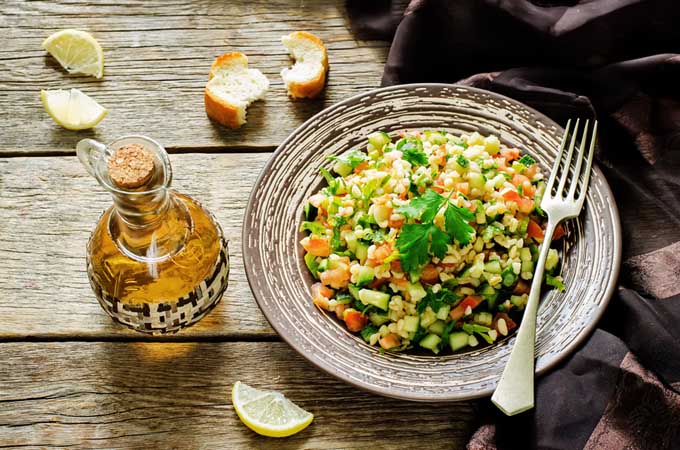
About Lorna Kring
Recently retired as a costume specialist in the TV and film industry, Lorna now enjoys blogging on contemporary lifestyle themes. A bit daft about the garden, she’s particularly obsessed with organic tomatoes and herbs, and delights in breaking bread with family and friends.


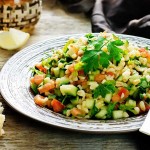



10 minutes ago, if you had asked me if I liked morrocan food, I would have laughed at you for assuming I’ve ever tried it. Looking at this article, now, I was so wrong. I’ve not only had, but Ioved it. My favorite is kebabs. I’m so glad I read this article. Now I can open up my kitchen to new possibilities!
Isn’t it interesting how far these influences have traveled, without our even realizing it? You’ve been rockin’ the casbah all this time!
I must say I haven’t had very many Moroccan dishes aside from kebabs. This needs to be remedied. I love sweet/sour pairings, and the cuisine uses so many of my favorite spices. Both the chicken tagine and the tabbouleh sound absolutely delectable. Now I’m seriously hungry, haha.
If you like the sweet & sour pairings, then you’ll love the tagine. It’s become one of my favorite stews, full of flavor and so easy to make – it just gets bonus points all around!
I really love learning the history and cultural influences of the cuisine. Morroco really has many influences. I wondered about the origin of the kebab, and this gives me some insight. There are several different religious influences and I find it interesting that the bread is so sacred. Another thing that intriques me is the combinations of the spices in their dishes. Thanks for sharing.
Thanks aphil, so glad you enjoyed the post. It’s a fascinating country with a very rich culture so evident in the cooking of today – and the appreciation of their daily bread is such a simple yet profound practice, very touching.
I’ve never tried my hand at tagine but I make tabbouleh as often as possible. The texture & the taste are right up my alley. Not to mention the fact that, despite the oil, it’s deceptively healthy. The Moroccan tagine is next on my list to make a staple.
Healthy and tasty, what a great combo – I can’t get enough of it, especially in the summer when the herbs and tomatoes are garden fresh. Have fun with the tagine, it’s one of those dishes that always seems to turn out well, regardless of the ingredients that go in.
With turmeric being called the next super food, I have been doing a lot of research into Moroccan foods, and may I tell you that you have not disappointed with this article! I actually attempted to make homemade Tabbouleh Salad from memory and I must say that it came no where close to the recipe you included in your post. I’m going to try it with your recipe for lunch tomorrow as I have most of the ingredients still. I will let everyone know how it turns out. Ahhh… give me mint tea and kebabs… I’m in heaven!
Glad you enjoyed the article IrishHeather! I think there’s a lot of variations of Tabbouleh, but this is the one that makes my heart sing… and do let us know how it turns out for you.
Oooh Moroccan food! Probably my favorite kind of Arabic cuisine — Algerians have tried to convince me, and Tunisians have the “spiciness” in their favour, but I really prefer the fruitiness of Moroccan — love to cook my couscous with raisins and orange juice! The taboule looks pretty nice and refreshing!
‘Fruitiness’, that’s a great description for Moroccan dishes. It was the surprising taste of Sultanas with the spices and savories that first got me hooked on tagines, they add such a wonderful little flavor bomb.
I was never a fan of the meat/fruit combination until I visited Agadir and tried a tagine! Even now, it remains the only dish where I will eat such a combination of foods.
It is an interesting combo, and it seems like the Morrocans have figured out how to pull it off with the spices they use – and the cooking method too, I think.
The places to visit in the future are…..budget requirements{mumbling and rumbling to myself}… a little frown crosses my face and there i go… in deep thought…then a sigh!…it shall be done someday {i say aloud}…snap and i come back to earth…that article just took me on a trip that i want to re-live mind, body and soul, i must visit Morroco someday…with this article in tow of-course 🙂
A foodie’s taste adventure to Morocco… sounds like a great trip!
Until now I had no idea that I had actually had Moroccan food! I already cook with turmeric as well. Some of the fruit and meat combinations seem odd until you try them. I’m going to look over these recipes to see if I have what I need and try some of them out. The Chicken Tagine looks delicious.
It is a bit surprising to learn how much of an influence Moroccan food actually has in our Western culture… enjoy the tagine, it’s very tasty.
I’m personally half-Jordanian and half of the foods you have mentioned here have reminded me of home. I absolutely love the couscous (I typically have it with lebaneh and chicken) and tabouleh. My dad typically makes tabouleh without cucumber and feta, so I may have to try this new recipe. 🙂 Thank you so much for writing this article! You should also give kibbeh a try if you haven’t already; that has to be one of my favorite foods (I’m not sure, however, if it is typical of Moroccan cuisine).
Oh, yes, kibbah… the football shaped ground savories on a skewer – they are wonderful, will have to dig deep to find my recipe for that. Thanks for commenting Liv6, glad you enjoyed the post!
Thank you for this thorough article. I actually had no idea about the culture and food before I clicked this article, and now I feel like I know a little bit. In my hometown Bucharest, Romania I always ate baklava but I didn’t know its roots. We also have a lot of Moroccan spices around here.
Glad you found the post interesting fuzyon. I imagine Bucharest would have been influenced by many trade route travelers bringing lovely spices and others goods to your part of the world.
Thanks for this article. My family and I love to try new kinds of food, and we’ve never even thought about Morrocan food. The spices and herbs used in the dishes sound amazing! I would love to try the Morrocan Chicken Tagine. It sounds relatively easy to make. Sweet dishes are not my favorite. Do you think if I left out the sweeter elements like raisins, brown sugar, and cinnamon that it would still be delicious and keep its Morrocan character, or am I missing the point?
Also, the Tabbouleh Salad sounds good as well. I’m not familiar with bulgur or where to buy it. I think I’ll go for the quinoa. Yummy!!!
The sweet elements in a tagine are really just a hint of flavor phoenix2015, and the sweet/sour combination is certainly an element of Moroccan cooking. But, I’m sure they could be eliminated without too much flavor loss… and the quinoa is a healthier choice than bulgur, and still tastes great! Glad you enjoyed the post.
My husband is from Morocco and I have tons of Moroccan cookbooks at home.
I have not tried every recipe yet and usually it is very hard to find the exact spices over here.
However, I am definitely intrigued to try these two recipes with the tangine and the salad.
Thanks so much.
Hope you enjoy the recipes sahara! The tagine has become my go-to stew in the winter months…
I love and appreciate your enthusiasm about the Moroccan cuisine, when reading your post as Moroccan it would have made more sense for me if this post was about the Lebanese/levantine cuisine. Which is a commonly made mistake, as many restaurants all over the globe mix this two cuisines. Which I believe is a mix made out of heaven, my favourite meal is to start with Lebanese mezzes and a lamb or beef Tajine with prunes as a main. I am going to explain the difference between the two cuisines. I want to emphasis I don’t want to criticise, by your post you seem genuinely interested in Moroccan food, so here’s a perspective from a Moroccan;
Baba ghanoush and Tabouleh are definitely not Moroccan but from the levant. Occasionally We do bbq skewers, but kebabs are more common in the Levant/Turkey. There is no Moroccan dish which contains yoghurt, but we love a Turkish yoghurt occasionally. Harira is a delicious Moroccan soup but there are no beans in it, lentils and chickpeas yes, but dates in the Harira?? No when we drink Harira we serve it with dates, but we don’t put them in the Harira, that sounds like horror to me.
Bisteeya is a Pie made of chicken and almonds in phyllo pastry, topped with sugar and cinnamon. I think what you tried to describe as bisteeya(bastilla) is Briwat, which can be sweet and savoury, the sweet ones contain almonds (not Cashews) in phyllo dough covered in honey and definitely NO couscous or custard. In Moroccan Arabic (darija) we don’t even have a word for custard, we use the french word creme Anglaise for custard.
Mescouta, is not a Date bar, it’s an orange cake. Although there is no fixed recipe for a tajine, but tomato and dried fruit with chicken are a No go. Dried fruit with Lamb or beef yes please, chicken goes with olives and pickled lemons. Chickpeas in a Tajine are a no go, we do love chickpeas but not in the Tajine. In the Harira or Couscous yes please and we eat chickpeas with bone marrow (KER3INE).
that said, If you like Moroccan food already now, I think you will be blown away if you go for it properly. I more than happy to share some authentic recipes. Let me know if you want to know more about the Moroccan cuisine.
Thanks for the effort sharing your thoughts about our lovely cuisine!